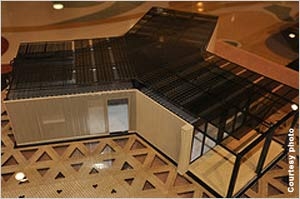 Washington — Why build a home from scratch when you can use boxes from the city port?
Washington — Why build a home from scratch when you can use boxes from the city port?
Some 20 architecture and engineering students at Tongji University in Shanghai decided to take advantage of material available at their coastal city’s many docks. Unlike most solar homes on the market today, theirs — they hoped — would be affordable.
This is the first year homes competing in the U.S. Department of Energy’s Solar Decathlon will be judged also on cost. The new rule recognizes that to build mass-market demand for solar-powered residential buildings, prices must come down.
Team China’s contribution to this year’s Solar Decathlon contest in late September in Washington is called the Y Container, because that’s exactly what it is: large shipping containers, six in all, that form a Y.
“We transformed standard shipping containers in order to compensate for the cost of photovoltaic technology,” Hua Guodong, the Tongji University team’s primary student architect, recently told the U.S. Department of Energy’s Energy Blog.
The rectangular steel containers are paired and placed atop a large deck that wraps around the house. The deck encourages socializing and has a second important function as a collector of rain water that is filtered for domestic use.
 Large windows and glass doors leading out to the deck bring light into the home, which on the inside looks like a modern, functional dwelling.
Large windows and glass doors leading out to the deck bring light into the home, which on the inside looks like a modern, functional dwelling.
The students at Tongji University designed the Y Container with their city in mind. Many young couples in Shanghai cannot afford independent housing, which is why, the Tongji students say, they looked for inexpensive, discarded and easily reconfigured material for their home.
Shanghai ranked 20th on Mercer LLC’s recent Worldwide Cost of Living Survey for cities, well ahead of historically expensive metropolises such as New York.
Beatrice Camp, the U.S. Consul General in Shanghai, called the design of the Y Container “remarkable” after visiting the home in June.
“Using recycled shipping containers to construct this Y-shaped house is a clever reminder that Shanghai is the world’s biggest shipping port,” she said. “By taking on the challenge to design a house that combines affordability, consumer appeal and design excellence with optimal energy production and maximum efficiency, you are writing your own page in the history of innovation.”
Xi Fengxin, an architecture student and member of the Tongji University Solar Decathlon team, said the Solar Decathlon is an experience that will stay with him for the rest of his life. The best thing of all, he said, “is that we built our own designed house with our own hands.”